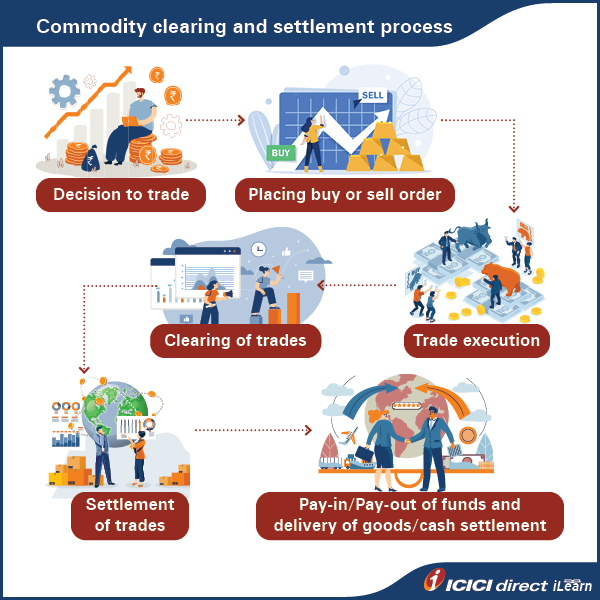Learning Modules Hide
Hide
- Chapter 1: Introduction to the Commodities Market
- Chapter 2: Understand Commodity Market Ecosystem in Detail
- Chapter 3: Understand the Working of Commodity Derivatives
- Chapter 4: Understand the Commodity Indices in Detail
- Chapter 5: Free Commodity Trading Course on Clearing and Settlement Process
- Chapter 6: Learn Risk Management for Commodity Derivatives
- Chapter 7: Understand Gold and Silver Bullion in Detail – Part 1
- Chapter 8: Bullions (Gold and Silver) – Part 2
- Chapter 9: Understand Crude Oil and Natural Gas in Detail – Part 1
- Chapter 10: Understand Crude Oil and Natural Gas in Detail – Part 2
- Chapter 11: Introduction to Base Metals
- Chapter 12: Understand Base Metals Derivatives Trading in India
- Chapter 13: Introduction to Agricultural Commodities
- Chapter 14: Understand the Uses of Commodity Derivatives
- Chapter 15: Learn Non-directional Trading Strategies in Commodities
- Chapter 16: Understand Legal and Regulatory Environment of Commodity Derivatives
Chapter 5: Free Commodity Trading Course on Clearing and Settlement Process
Assume you are buying a new car from a showroom by issuing a cheque. The car showroom delivers the vehicle (settlement) to you after the amount is received from the bank (clearing). Likewise, trading in commodity derivatives or any financial instrument involves clearing and settlement. Let us understand this concept in detail.
Clearing corporation
|
Did you know? Transactions done on MCX are settled through MCX Clearing Corporation Limited. |
Clearing is one of the important spokes of any financial transaction, essential for completing the process of buying and selling by different parties. The commodities you buy and sell on any trading day are settled through a clearing corporation. To complete the settlement of trades done on an exchange platform, these clearing corporations collect margins from you through both the exchange and the broker, deal with payments in the form of pay-in and pay-out as well as the delivery mechanism. Exchanges and clearing corporations carry out their roles and responsibilities independent of each other for smooth operations in the ecosystem.

Clearing and settlement
Clearing refers to the process of accounting to update and reconcile obligations/payments
of parties involved in the trade.
Example: Assume that you bought gold at Rs. 50,500 per 10 grams during a particular trading session and the market closed on that day at Rs. 50,800 per 10 grams. In this case, the market closing is higher than your purchase price. Hence, your ledger shows a profit of Rs. 300 per 10 grams and vice versa if the market closes below your purchase price. At the exchange level, somebody’s loss is somebody’s profit. This process happens every day after closing of the market and it also helps in marking your position.
Settlement involves matching outstanding buy and sell instructions by transferring ownership of commodities against funds between buyer and seller.
Example: You bought copper at Rs. 800 per kg and intend to take delivery of the material through the exchange platform. In this case, the exchange finds a seller against your buy position and arranges for transfer of goods between the seller and you against funds between buyer and seller.
Process of clearing and settlement
- Commodity exchanges transmit trade details to clearing corporations on a real time basis
- Upon receipt of trade details, the clearing corporation/clearing house notifies trading members about obligations
- Clearing members receive communication regarding obligation and pay-in advice of funds
- Clearing banks are instructed to make funds available by pay-in time
- Pay-in of funds for executed trades is carried out by clearing banks by debiting the account of clearing members and crediting the account of the clearing corporation account with the amount due to them
- Pay-out of funds is done based on the instructions of the clearing corporation by clearing banks and credited to the account of clearing members, as applicable
Let us understand this through an example.
ABC Limited and XYZ Limited are two clearing members of an exchange. Kabir is a client of ABC Limited and Nimish is client of XYZ Limited.
|
Clearing members |
ABC Limited |
XYZ Limited |
|
Name of client |
Kabir |
Nimish |
|
Trade |
Buys 1 kg gold at Rs. 50,000 per 10 grams |
Sells 1 kg gold at Rs. 50,000 per 10 grams |
|
Margin required at 10% |
50000*100*10% = Rs. 5,00,000 |
50000*100*10% = Rs. 5,00,000 |
|
Market closes at Rs. 50,500 per 10 grams |
||
|
Profit / Loss |
Kabir gains Rs. 50,000 |
Nimish loses Rs. 50,000 |
|
Clearing process |
Pay-out of Rs. 50,000 to Kabir |
Pay-in of Rs. 50,000 from Nimish |
Thus, on every trading day, till the expiry of the Futures Contract, there is some amount of
MTM (Mark-to-Market) gain equal to MTM loss, across members, which needs to be settled.
Entities involved in the clearing and settlement process
The Indian commodity derivatives ecosystem involves various intermediaries for clearing and settling trades namely, clearing members, clearing corporations, clearing banks, custodial services, warehouse service providers and e-registry service providers, etc.
Please refer to Chapter 2 of this module for additional details on these entities.
Delivery process
The commodity market is distinct from the equity market because of delivery of commodities between buyers and sellers. Upon expiry of contracts, commodities are exchanged physically between buyers and sellers thereby making this market quite useful for organisations engaged in use of commodities for their manufacturing process.
The commodity market has adopted three types of deliveries namely, compulsory delivery, sellers’ option and intention matching.
In compulsory delivery, all open positions, upon expiry of contracts, need to be settled physically.
In sellers’ option, sellers will have an edge while selecting delivery location and quantity.
|
Did you know? In agricultural and non-agricultural commodities, the penalty for delivery default by seller will be 4% and 3% of the settlement price plus replacement cost respectively. |
In intention matching, physical delivery happens only when both buyer and seller agree to exchange the physical commodity.
Here’s a tip: Exchanges have a mechanism of tender delivery period, which starts five days prior to expiry of a contract. Before start of this tender delivery period, one is allowed to exit from an open position to avoid entering into delivery process.
Contract expiry details
|
Commodity |
Expiry date |
|
Gold 1 kg |
5th of the expiry month |
|
Gold Mini |
5th of the expiry month |
|
Gold Guinea |
Last trading day of the expiry month |
|
Gold Petal |
Last trading day of the expiry month |
|
Silver |
5th of the expiry month |
|
Silver Mini |
Last trading day of the expiry month |
|
Silver Micro |
Last trading day of the expiry month |
|
Crude Oil |
19th of expiry month |
|
Natural Gas |
26th of expiry month |
|
Aluminium |
Last trading day of the expiry month |
|
Copper |
Last trading day of the expiry month |
|
Lead |
Last trading day of the expiry month |
|
Nickel |
Last trading day of the expiry month |
|
Zinc |
Last trading day of the expiry month |

Additional margin during tender period is required to confirm the commitment by the buyer and seller and to avoid a default in delivery process.
Premium/Discount
Since commodities traded on Indian exchanges are deliverable contracts, the quality of these commodities matters a lot when it comes to physical exchange of commodities. While designing a contract, the exchanges specify acceptable quality standards. The quality parameters of manufactured products are maintained uniquely. However, it is very difficult to maintain naturally produced commodities. The quality specifications of bullion and metals remain same at all times. However, the quality of agricultural products varies due to multiple factors. In such cases, the exchange notifies the premium and discount for quality of agricultural commodities. If the quality of produce is greater than the contract specification, it will fetch a premium and, if the quality is lower than the contract’s specifications but within acceptable limits, it is settled at a discount.
Following are examples of premium and discount calculations.
Premium
Castor seed Futures are available for trading on NCDEX. Its quality is largely dependent on oil content, which is 47%. If you deliver castor seeds with 49% oil content, you may get 2% additional price.
The premium calculation is illustrated as follows:
Price of castor seed with 47% oil content: Rs. 7,300 per quintal
Price of castor seed with 49% oil content = Rs. 7,300 + (Rs. 7,300 X 2%) = Rs. 7446
Discount
MCX cotton with moisture content of 8.5% is the most preferred quality and the exchange accepts cotton with moisture up to 9.5% with discount. The calculation of discount is illustrated below:
Cotton price = Rs. 37,000 – (Rs. 37,000*1%) = Rs. 36,630 per bale.
Penalty for delivery default
It is a well-known fact that the commodities traded at Indian exchanges are deliverable contracts in some cases. In order to avoid delivery defaults, the SEBI has laid down guidelines for defaults. Delivery default norms are laid out to strengthen the ecosystem and to ensure adequate compensation to an aggrieved party.
Delivery default by seller: If the seller defaults after indicating delivery intention, the seller has to pay 4% of the settlement price plus replacement cost in case of agri commodities and 3% of the settlement price plus replacement cost in case of non-agri commodities to an exchange.
Delivery default by buyer: If the buyer defaults after indicating delivery intention, the clearing corporation shall review the loss incurred by the non-defaulting party i.e., the seller at its sole discretion.
The penalty collected from defaulting parties are utilised as follows:
- At least 1.75% is deposited in the Settlement Guarantee Fund of the clearing corporation.
- Up to 0.25% is retained by the clearing corporation towards administrative expenses.
- The affected party receives 1% in case of non-agri goods and 2% in case of agri goods plus replacement cost.
Summary
- Clearing and settlement are the two most important aspects of commodity derivatives trading that ensure smooth functioning of the system.
- The clearing process involves accounting of trades as well as pay-in/pay-out while the settlement process involves matching outstanding buying and selling positions as well as ensuring physical delivery of commodities.
- There are three types of physical deliveries on commodity exchanges: compulsory delivery, sellers’ option and intention matching.
- Exchanges have a provision to penalise the parties that default in taking/making physical deliveries after expiry of the contract.
- Exchanges also have premium and discount mechanisms to offer fair pricing on commodities with varied quality.
- Retail participants who do not wish to take/make deliveries need to exit their positions five days prior to the expiry of a contract.
The next chapter will take you through risk management in commodity derivatives, types of risks that could hamper trading as well as risk containment measures.

 Top Mutual Funds
Top Mutual Funds





COMMENT (0)